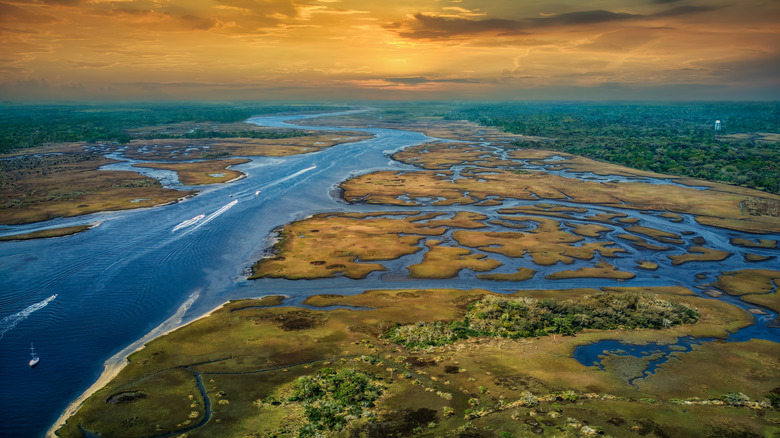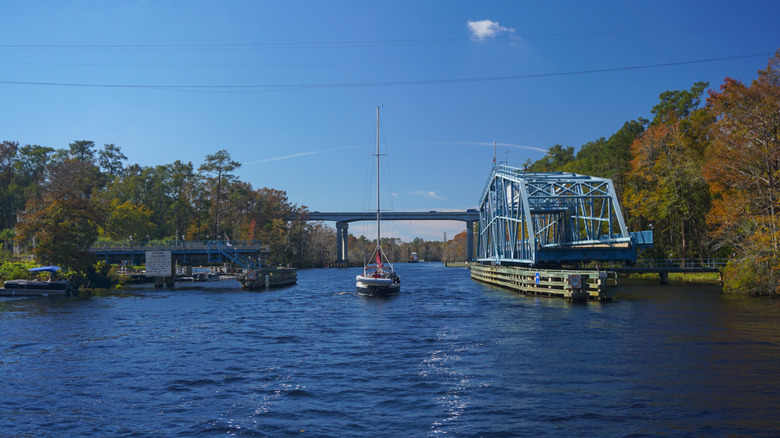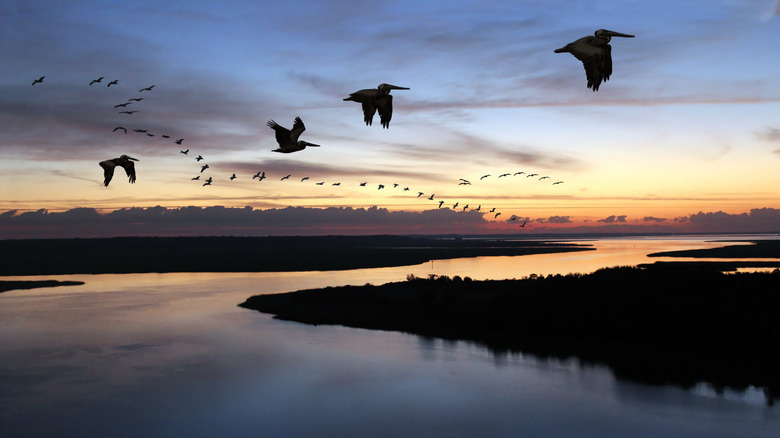A Hidden East Coast Waterway Known As 'The Ditch' Offers A Wealth Of Recreation And Wildlife
If you've visited coastal areas of the Carolinas or Florida, chances are you've seen part of a seemingly endless waterway that runs up the East Coast. This series of rivers, sounds, and canals known as the Atlantic Intracoastal Waterway, or ICW for short, connect to allow boats to travel the 1,088 miles from Norfolk, Virginia, to Key West, Florida, without venturing into the open Atlantic. Some parts of the route are essential to commerce, like the section that bypasses the notorious "Graveyard of the Atlantic" in North Carolina. But the whole route is a favorite of recreational boaters who use it to move between seasons.
The ICW's nickname, "The Ditch," comes from a few sections of man-made canals that do fit the billing: They're narrow, crowded, and unforgiving places lined with seawalls and docks. But most of the trip is undeserving of the ugly nickname, with the route following beautiful, winding, natural rivers and bays through forests and marshlands. Dolphins often share the waters with you as ospreys and pelicans soar overhead. Fish are everywhere, and birds like cormorants, egrets, and eagles are a common sight.
While it's easy to get enamored with the ICW as the journey of a lifetime, it's just part of life for the towns connected to it. For example, the waterway in South Florida connects homes, canals, and marinas to the ocean. Fort Lauderdale is only the "Venice of America" because the ICW connects it all. Along the waterway, boaters zip between towns for a quiet morning fishing, an afternoon relaxing at the sandbar, lunch at their favorite dock-and-dine, or nothing more than a day spent on the water.
Puttering along the Atlantic Intracoastal Waterway
The ICW changes as you pass through different states, but there are two distinct vibes along the way. One comes from the wild, natural places you can only get to by boat and the interesting side trips you can take along the sounds and rivers. Boaters call this style of exploring and anchoring for the night "gunkholing," akin to boondocking in an RV. Possible detours in North Carolina alone include the historic canal through the Great Dismal Swamp or out to Ocracoke, one of the least visited Outer Banks villages.
Stopping in the many small towns along the way is the other appeal of the ICW. There are places like the small, beachy town of Beaufort, North Carolina, nearby Southport, or welcoming Fernandina Beach, Florida. You might not think to visit these gems on a road trip, but arriving by boat makes them truly special. You pass a few big cities, too — but not many. Norfolk, Charleston, West Palm Beach, Fort Lauderdale, and Miami are the only ones you'll see up close.
If you plan to do the entire ICW route, the most common type of vessel used is a cruising sailboat or powerboat. These allow you to stay aboard every night, cook your meals, and live comfortably for the month or two that the journey takes you to complete. A liveaboard vessel like this may move slowly, but it is your vacation home, too. In many ways, boat life on the waterway mimics RV life on land.
Planning an ICW adventure of a lifetime
Boaters divide their nights between staying in town at marinas and swinging at anchor in protected, quiet bays. If you have a smaller boat, you can stay at marinas and hotels every night and eat out. Adventurous folks have even completed the trip on small craft like open center consoles, jet skis, or even kayaks. If you're not a boater and have no interest in becoming one, American Cruise Lines gives you a taste of the ICW without the hassles of boat ownership. They have small ships and several itineraries that travel parts of the ICW, calling on the towns and letting you experience the nautical life.
The ICW is heavily used during the changes of seasons. Snowbird boaters head south every fall to spend winter in Florida or the Bahamas and then go north in the spring to avoid the heat, humidity, and hurricanes. But, outside of severe weather events, there's no off-season on the ICW. Boaters are out in all seasons, traveling sections between towns on days with nice weather.
If the ICW whets your appetite for more, know that it's just a tiny part of America's Great Loop. The Great Loop is a path that follows similar waterways and rivers around the eastern half of the U.S., going all the way up the ICW and the Chesapeake Bay, through the New York canal system, into the Great Lakes, and south to the Gulf through the Western Rivers. There's also the Gulf Intracoastal Waterway, which connects South Florida to Brownsville, Texas.


